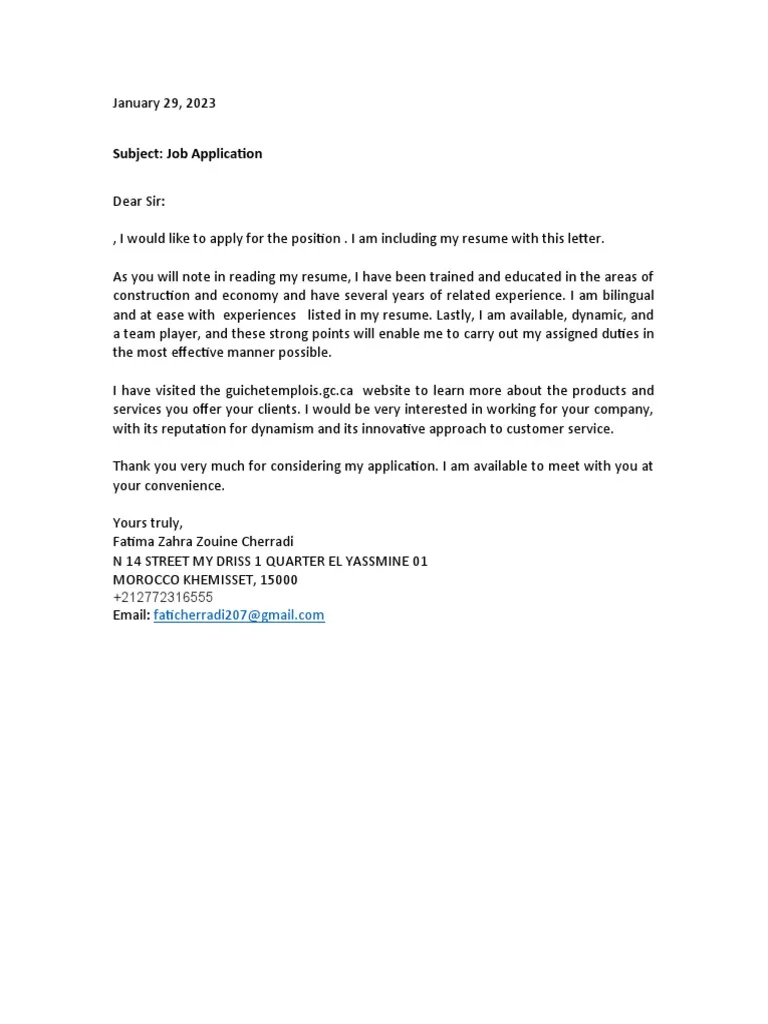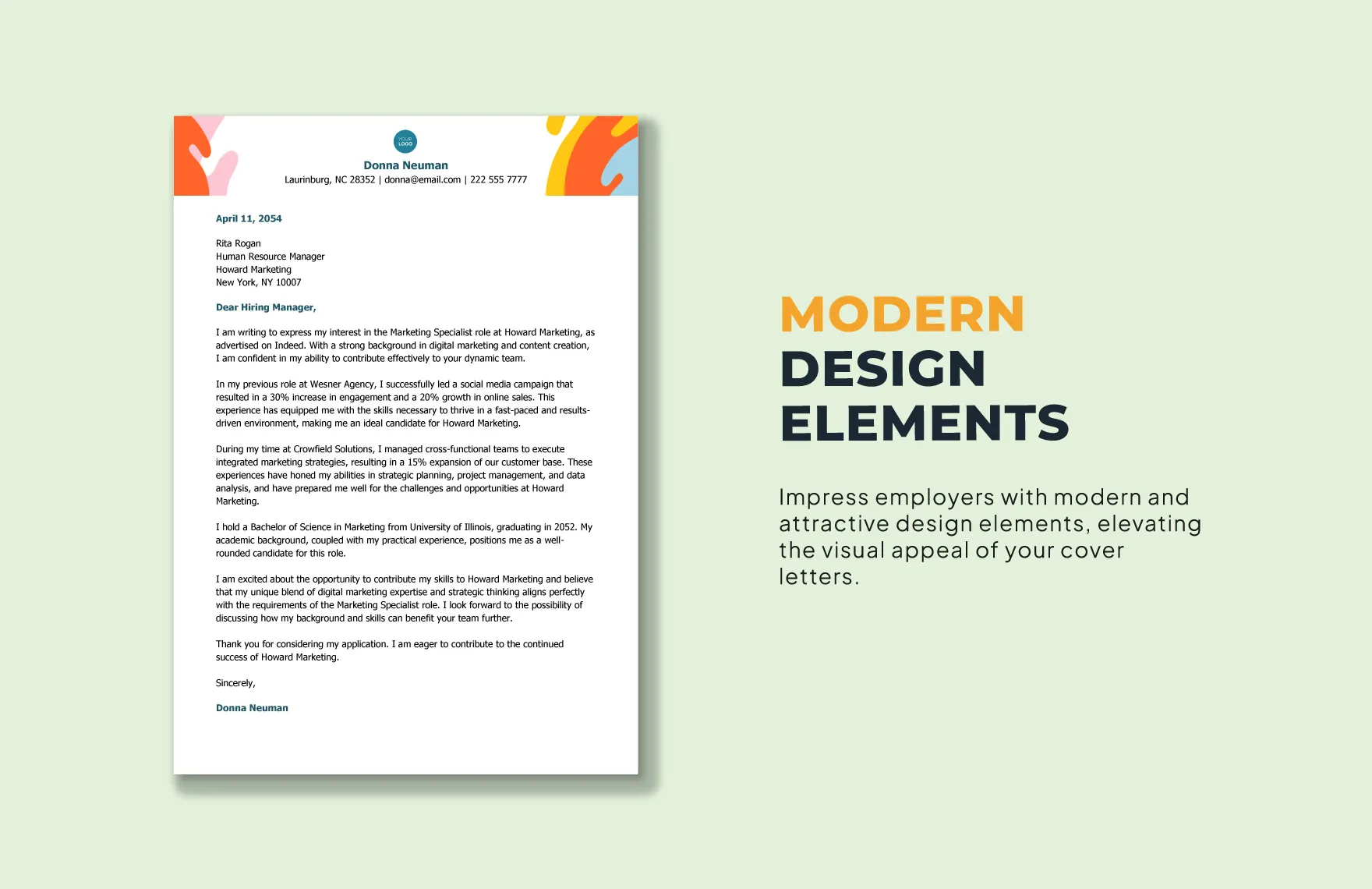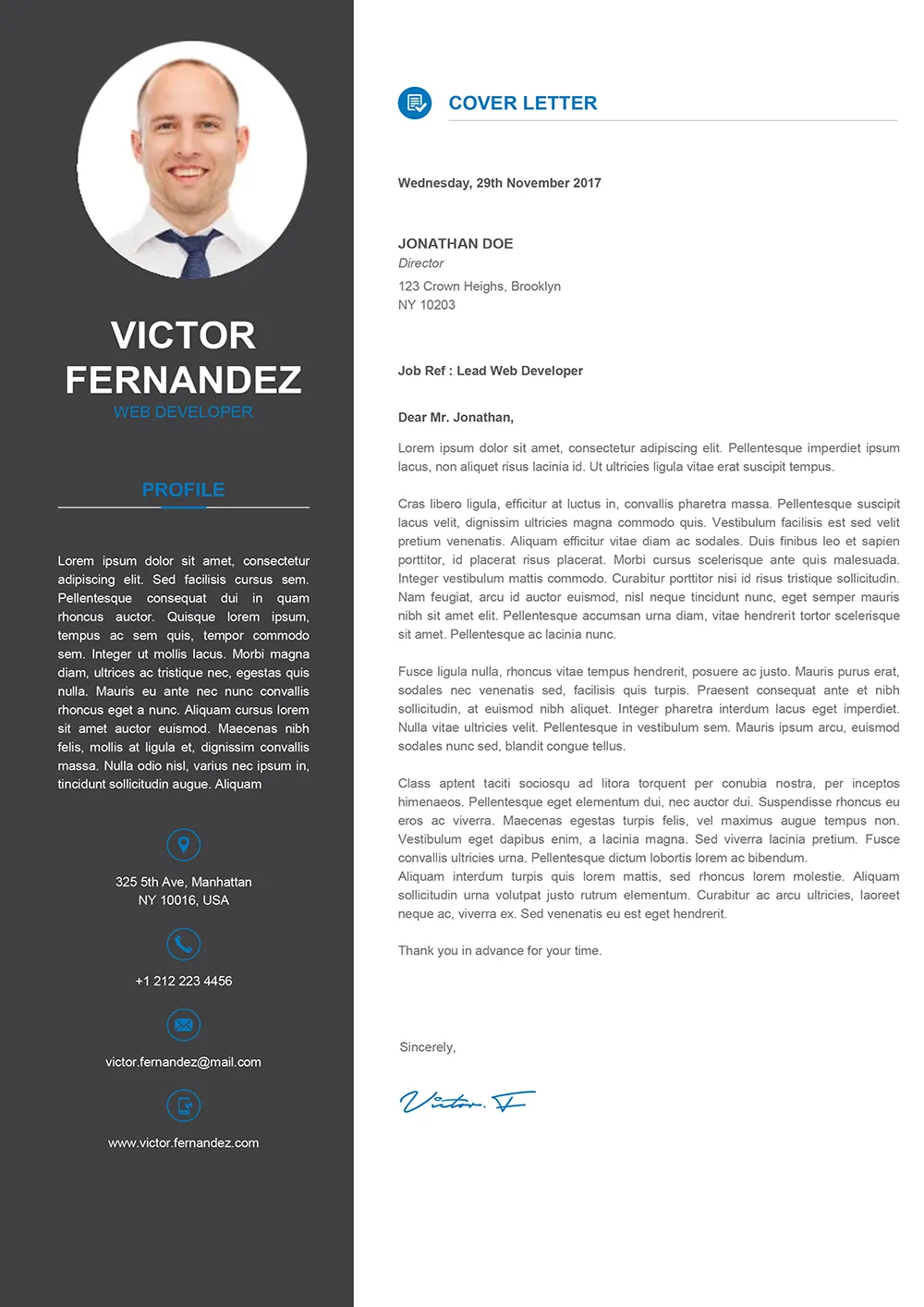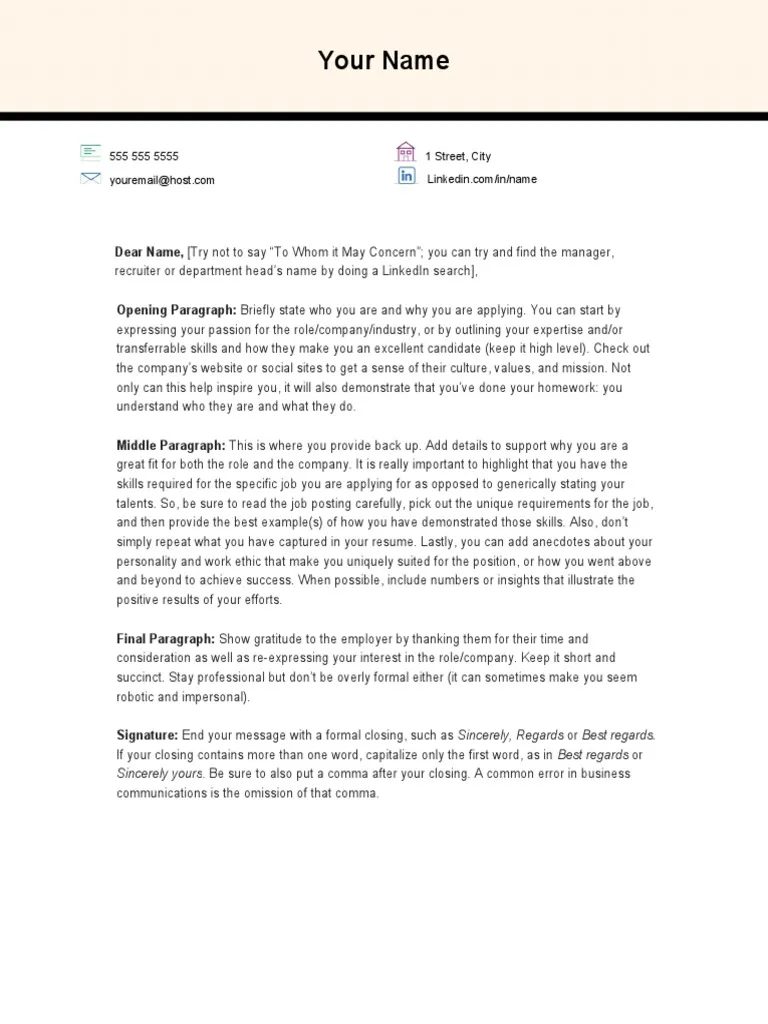Why Cover Letters Still Matter
In an era dominated by online applications and digital resumes, many job seekers question the continued relevance of cover letters. The truth is, a well-crafted cover letter remains a powerful tool in your job search arsenal. It provides a unique opportunity to go beyond the confines of your resume and showcase your personality, passion, and the specific value you bring to a potential employer. Resumes, by nature, are static documents, presenting a chronological overview of your experience and skills. Cover letters, on the other hand, allow you to tell a story, to connect the dots between your past experiences and the requirements of the job, demonstrating a genuine interest in the company and the role. They allow you to highlight specific achievements, explain career gaps, and address any concerns the hiring manager might have, ultimately increasing your chances of landing an interview. The ability to articulate your skills and experiences in a compelling and personalized manner sets you apart, signaling to the recruiter that you are serious about the opportunity and have taken the time to tailor your application. Therefore, never underestimate the value of a strong cover letter – it could be the key to unlocking your dream job.
What Makes a Great Cover Letter
A great cover letter is more than just a summary of your resume; it’s a compelling narrative that grabs the reader’s attention from the start. It needs to be concise, engaging, and tailored to the specific job and company you are applying for. The best cover letters showcase your personality, highlighting your enthusiasm and genuine interest in the role. They immediately establish a connection with the hiring manager by demonstrating that you understand the company’s mission, values, and needs. To achieve this, you must research the company, understanding its current projects, challenges, and goals. This knowledge allows you to address how your skills and experience directly align with their requirements. Avoid generic templates; a great cover letter is personalized, clearly demonstrating your understanding of the role and your ability to contribute to the company’s success. It should also be error-free, both in grammar and spelling. A well-written cover letter reflects professionalism and attention to detail, which are vital qualities in any workplace. The inclusion of quantifiable achievements is also important; it provides concrete evidence of your capabilities and the impact you’ve made in previous roles. Finally, always end with a strong call to action, expressing your eagerness for an interview and your commitment to the next steps of the hiring process.
Key Components of a Cover Letter

A well-structured cover letter is essential for making a strong first impression. Begin with a professional header that includes your contact information, followed by the date and the recipient’s details. A clear and concise introduction is crucial; state the position you are applying for and how you discovered the opportunity. The body of the letter should be organized into several paragraphs, each addressing a specific aspect of your qualifications and why you are a good fit. In these paragraphs, highlight your relevant skills and experiences, using examples to support your claims. Quantify your achievements whenever possible. If you increased sales by a certain percentage or streamlined a process to improve efficiency, include it. Show how your skills and experience meet the requirements of the job description and relate your skills to the company’s objectives. Don’t simply restate your resume; rather, elaborate on specific experiences and demonstrate how they translate into value for the employer. Conclude with a strong closing paragraph, reiterating your interest in the position, expressing your gratitude for their time, and providing a clear call to action—such as requesting an interview. Remember, the key to a compelling cover letter lies in personalization, attention to detail, and the ability to show how your skills and experience align with the company’s specific needs.
Personalizing Your Cover Letter
Personalization is the cornerstone of a successful cover letter. Generic, one-size-fits-all letters are easily spotted and often discarded. To personalize your letter, begin by researching the company. Understand their mission, values, and recent projects. Mention specific aspects of the company or role that excite you. Tailor your letter to the job description by carefully reviewing the requirements and addressing how your skills and experiences align with those needs. Identify keywords used in the job posting and incorporate them naturally into your letter. This demonstrates your understanding of what the employer is looking for and that you have taken the time to consider their needs. It’s also crucial to address the hiring manager by name, if possible. This shows that you have done your homework and taken the extra step to make a personal connection. Avoid simply restating your resume; instead, elaborate on specific experiences and showcase how they have equipped you for the role. Show, don’t just tell. Personalization also extends to the tone of your writing. Let your personality shine through, but maintain professionalism. Remember, your goal is to stand out from the crowd by showcasing your genuine interest and suitability for the position.
Cover Letter Example 1 The Enthusiastic Approach
The enthusiastic approach to a cover letter highlights your passion, energy, and genuine excitement for the role and the company. Start by expressing your genuine interest and making it clear why you are drawn to the opportunity. Instead of simply stating your qualifications, infuse your letter with enthusiasm. Talk about how the company’s mission resonates with you, or why their work in a particular area excites you. Be specific in mentioning projects, initiatives, or products that have captured your interest. When describing your skills and experience, use dynamic language that conveys energy and eagerness to contribute. Show, rather than tell, using vivid examples to illustrate your abilities and achievements. Highlight how your positive attitude and proactive approach can make a difference within the team. The enthusiastic approach makes you memorable, making you appear personable, approachable, and eager to contribute. Tailor this approach to jobs where your personality can shine, such as customer service, sales, or team leadership roles. Remember, the key is to balance your enthusiasm with professionalism and a clear demonstration of your qualifications.
Cover Letter Example 2 The Skills-Focused Approach

The skills-focused approach to a cover letter emphasizes your abilities and how they directly align with the requirements of the job. This approach is most effective when applying for roles where specific skills are crucial. Begin by identifying the key skills the employer is seeking, based on the job description. In your cover letter, highlight these skills with specific examples. Instead of listing skills, weave them into your narrative, demonstrating how you’ve used them to achieve results in previous roles. Use action verbs to describe your experiences, and provide quantifiable achievements whenever possible. This provides concrete evidence of your capabilities and their impact. For example, if a job requires project management skills, detail how you successfully managed a project from start to finish, including the challenges faced and the solutions you implemented. If you have experience with specific software or tools, mention it, providing examples of how you’ve utilized them. The skills-focused approach is about connecting your abilities to the employer’s needs, showing that you have the practical experience to succeed in the role. This approach often works well for technical, analytical, or specialized positions.
Cover Letter Example 3 The Value-Driven Approach
The value-driven approach to a cover letter focuses on the benefits you bring to the employer, showcasing how your contributions will positively impact the company. This approach is particularly effective when you have a track record of achieving significant results. Begin by identifying the key challenges or goals of the company, ideally through research and industry knowledge. Then, in your cover letter, articulate how your skills and experience can directly address those needs and contribute to their success. Use quantifiable data to demonstrate the value you’ve provided in previous roles. Did you increase revenue, reduce costs, or improve efficiency? Back up your claims with concrete evidence. When describing your accomplishments, focus on the impact you made, the specific problems you solved, and the benefits the employer received. Connect your past achievements to the employer’s current needs, showing them that you understand their business and can contribute to their future success. This approach is ideal for roles where you can demonstrate a clear return on investment, such as sales, marketing, or leadership positions. Make it clear the value you bring to the company.
Cover Letter Example 4 The Networking Approach
The networking approach leverages connections to gain a competitive edge. This approach often works well if you have a contact within the company or know someone who can provide a referral. Begin by mentioning the connection in your cover letter’s opening paragraph. This could be a mutual acquaintance, someone you’ve met at an industry event, or a current employee who recommended you for the role. Mentioning the connection right away, demonstrates that you are serious about the opportunity. In the body of your letter, highlight your relevant skills and experience, and explain how your background aligns with the job requirements. Use the referral as an opportunity to show your understanding of the company and what makes them stand out. Express your genuine interest in the opportunity and a willingness to learn more about the company. If appropriate, include a brief statement about how the connection spoke positively about the company culture or the role, which can further show your genuine interest. The networking approach often increases your chances of getting noticed, especially when applying to companies with a strong emphasis on internal referrals. Always be respectful of your connection and express gratitude for their help.
Cover Letter Example 5 The Concise Approach

The concise approach is characterized by its brevity and directness, focusing on the most important information in a clear and efficient manner. It is particularly useful when applying for roles where the ability to communicate clearly and concisely is highly valued. Begin by stating the position you are applying for and a brief summary of why you are a good fit. Focus on your most relevant skills and experiences. Instead of a lengthy narrative, use bullet points or short paragraphs to highlight your key achievements and qualifications, making the letter easy to read and digest. Emphasize quantifiable results. The key to a concise cover letter is to focus on the most relevant information, eliminating any unnecessary details. Keep the tone professional and avoid flowery language or unnecessary jargon. Your goal is to convey your key qualifications and demonstrate your understanding of the role in as few words as possible. This approach is well-suited for roles in fields such as finance, law, or engineering, where clarity and precision are essential. Tailor the concise approach to the job description.
Tips for Perfecting Your Cover Letter
Perfecting your cover letter is crucial for making a strong impression. Begin by proofreading carefully for any grammatical errors, spelling mistakes, and typos. These errors can detract from your professionalism and negatively impact your chances of getting an interview. Always use a professional tone and formal language. Avoid slang, jargon, and overly casual expressions. Research the company and the role thoroughly. Tailor your cover letter to the specific requirements of the job, showing how your skills and experience align with what the employer is looking for. Highlight your accomplishments, not just your responsibilities. Use the STAR method (Situation, Task, Action, Result) to describe your experiences in detail. Quantify your achievements whenever possible, using numbers and data to demonstrate the impact you’ve made in previous roles. Keep your cover letter concise and focused. Avoid rambling or including unnecessary details. Keep the letter to one page. Ensure the layout is clean, professional, and easy to read. Use a standard font, such as Times New Roman or Arial, and use clear headings and bullet points to organize the content. Before submitting your cover letter, review the job description one last time and make sure you’ve addressed all the key requirements. After you create the cover letter, ask someone else to read it over. A fresh pair of eyes can catch errors you might have missed.
Proofreading and Formatting Your Cover Letter
Proofreading and formatting are essential steps in the cover letter writing process. Before sending, thoroughly proofread your cover letter for any grammatical errors, spelling mistakes, and typos. It is recommended to read the letter aloud to catch any awkward phrasing or run-on sentences. Ensure consistency in your formatting. Use a standard font such as Times New Roman or Arial, and maintain consistent font sizes and styles throughout the document. Pay attention to spacing and alignment, ensuring that your letter is visually appealing and easy to read. Use clear headings and bullet points to organize your content, making it easier for the hiring manager to scan and understand your key qualifications. Ensure that your contact information is accurate and up to date, including your phone number and email address. Finally, review your cover letter on different devices to ensure it displays correctly on all platforms. Proofreading and formatting are the final touches. They show you are a detail-oriented professional, increasing your chances of making a positive impression.
The Impact of a Strong Cover Letter

A strong cover letter significantly impacts your job search. It can make the difference between landing an interview and being passed over. A well-written cover letter introduces your skills and experiences to the hiring manager, making a positive first impression and demonstrating that you have taken the time to understand the role and the company. A compelling cover letter will highlight your unique value proposition, explaining how your skills and experiences align with the employer’s needs. It allows you to tell a story, showcasing your personality and passion for the role, helping you stand out from other candidates. By tailoring your cover letter to the specific job requirements, you are showing the hiring manager that you have a genuine interest in the opportunity and are not simply sending out generic applications. The impact extends beyond just securing an interview. A strong cover letter sets the stage for future communication, demonstrating your communication skills and attention to detail. It can influence how the hiring manager perceives you and may even lead to a higher starting salary or more favorable terms of employment. A strong cover letter is an investment in your future.
